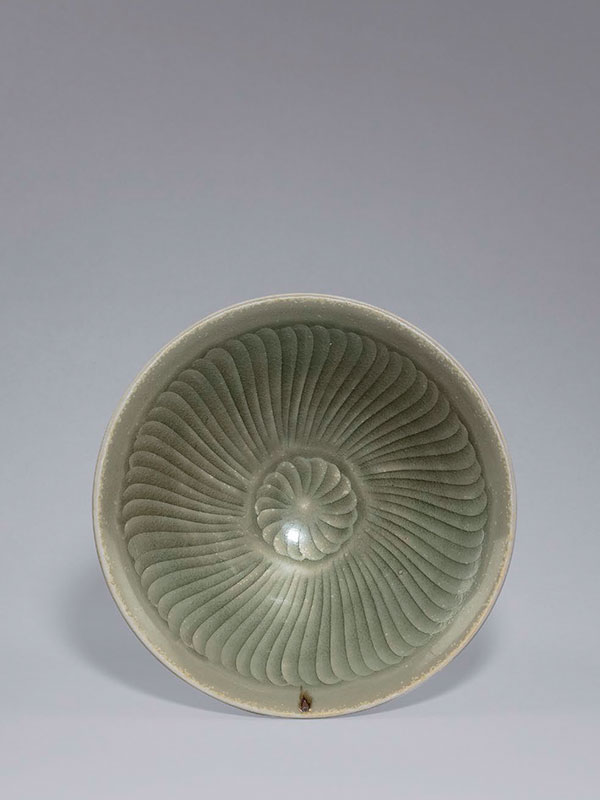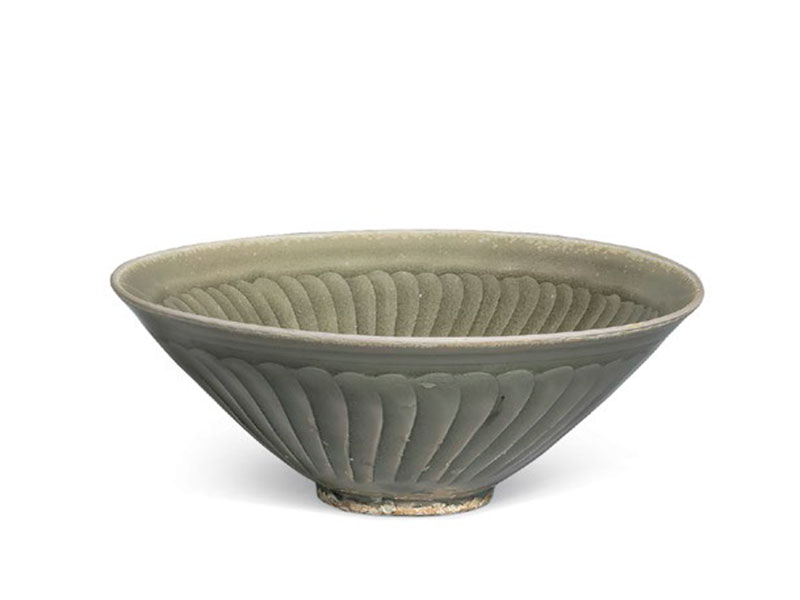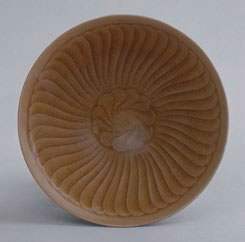Yaozhou stoneware bowl
A stoneware bowl of conical shape, the deeply rounded sides supported on a low foot and terminating in a straight rim. The interior of the bowl is carved with a pattern that imitates overlapping chrysanthemum petals with a medallion in the centre. The exterior is similarly carved with chrysanthemum petals radiating from the foot towards the rim. The bowl is entirely covered in a lustrous, translucent pale olive-green glaze with yellowish hue, which pools to a slightly darker colour in the recesses. Small clusters of kiln grit adhere to the base.
The elegance of this stoneware bowl is expressed both in the fine, competent potting and the delicately carved chrysanthemum design. The bowl has been executed on a wheel, after which the sides were thinned down using a special tool. Chrysanthemums (ju) are known as the ‘gentleman of flowers’ and symbolise intellectual accomplishments; they are also associated with the number nine and autumn, due to the fact that they begin blooming in the ninth month of the year.[1] The Chinese fascination for green-glazed high-fired wares goes back to the introduction of the earliest glazes and in the case of yaozhou wares, continued well into the 14th century.[2] The pale olive-green glaze with yellowish hue, an indication of an earlier piece, is celebrated for its rarity among Yaozhou wares. The yellowish hue of the glaze is due to a reducing atmosphere in the wood-fuelled kiln, which gradually disappeared when the kilns switched from wood to coal. An almost identical celadon Yaozhou bowl with a closely comparable chrysanthemum design and colour of the glaze, dated to the Northern Song dynasty, is in the collection of the Palace Museum, Beijing (fig. 1).[3] Another closely comparable example, restored with gold (kintsugi, ‘golden joinery’ technique), is in the collection of the Victoria and Albert Museum.[4]
- Welch, P. B. Chinese Art – A Guide to Motifs and Visual Imagery, Tuttle Publishing, 2012, p. 24
- Mino, Y. and Tsiang, K. R. Ice and Green Clouds, Traditions of Chinese Celadon, Indianapolis Museum of Art, 1986, p. 13
- The Palace Museum, Beijing online collection archive, no. 新118320, http://www.dpm.org.cn/collection/ceramic/227502.html
- Victoria and Albert Museum online collection archive, museum number: C.622-1918
耀州窯青釉刻花菊瓣紋碗
北宋 960 – 1127
徑:14.2 公分 高:5.4 公分
斗笠式碗,敞口,圈足,碗內外側均刻有菊瓣紋,碗心刻一團花。通體施橄欖綠青釉,釉色青中泛
黃,口沿與圈足內剝釉,露出灰白細胎。菊花為四君子之一,象徵文人品德「素心常耐冷,晚節本
無瑕」的內涵,並藉以比喻人的德性圓滿,為政清廉。北京故宮博物院藏有一件北宋耀州窯青釉菊
瓣紋碗,惟碗底內團花紋稍有差異,尺寸與刻花均與本品極為相似。英國維多莉亞與亞伯特博物館
亦藏有一件相似碗,但有日本金繼修復痕。
來源:澳大利亞私人收藏。香港聯齋古玩號。倫敦心雅齋(Berwald Oriental Art)。英國私人收藏。



